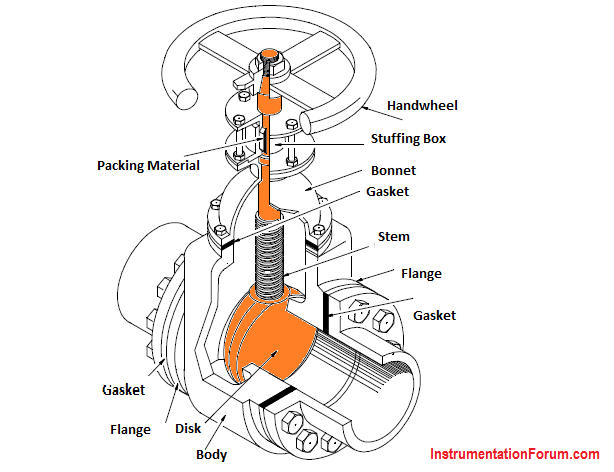Gate valves are available with a variety of disks. Classification of gate valves is usually made by the type disk used:
- solid wedge
- flexible wedge
- split wedge
- parallel disk
Solid wedges, flexible wedges, and split wedges are used in valves having inclined seats. Parallel disks are used in valves having parallel seats.

Regardless of the style of wedge or disk used, the disk is usually replaceable. In services where solids or high velocity may cause rapid erosion of the seat or disk, these components should have a high surface hardness and should have replacement seats as well as disks. If the seats are not replaceable, seat damage requires removal of the valve from the line for refacing of the seat, or refacing of the seat in place. Valves being used in corrosion service should normally be specified with replaceable seats.
Gate Valve Stem Design
Gate valves are classified as either rising stem or non rising stem valves. For the non rising stem gate valve, the stem is threaded on the lower end into the gate. As the hand wheel on the stem is rotated, the gate travels up or down the stem on the threads while the stem remains vertically stationary. This type of valve will almost always have a pointer-type indicator threaded onto the upper end of the stem to indicate valve position.
The non rising stem configuration places the stem threads within the boundary established by the valve packing out of contact with the environment. This configuration assures that the stem merely rotates in the packing without much danger of carrying dirt into the packing from outside to inside.
Rising stem gate valves are designed so that the stem is raised out of the flow path when the valve is open. Rising stem gate valves come in two basic designs. Some valves have a stem that rises through the hand wheel while others have a stem that is threaded to the bonnet.
Gate Valve Seat Design
Seats for gate valves are either provided integral with the valve body or in a seat ring type of construction. Seat ring construction provides seats which are either threaded into position or are pressed into position and seal welded to the valve body. The latter form of construction is recommended for higher temperature service.
Integral seats provide a seat of the same material of construction as the valve body while the pressed-in or threaded-in seats permit variation. Rings with hard facings may be supplied for the application where they are required.
Small, forged steel, gate valves may have hard faced seats pressed into the body. In some series, this type of valve in sizes from 1/2 to 2 inches is rated for 2500 psig steam service. In large gate valves, disks are often of the solid wedge type with seat rings threaded in, welded in, or pressed in. Screwed in seat rings are considered replaceable since they may be removed and replaced.